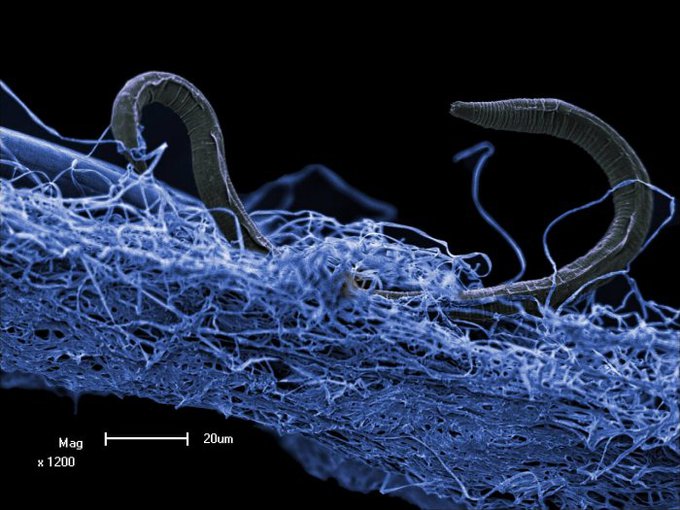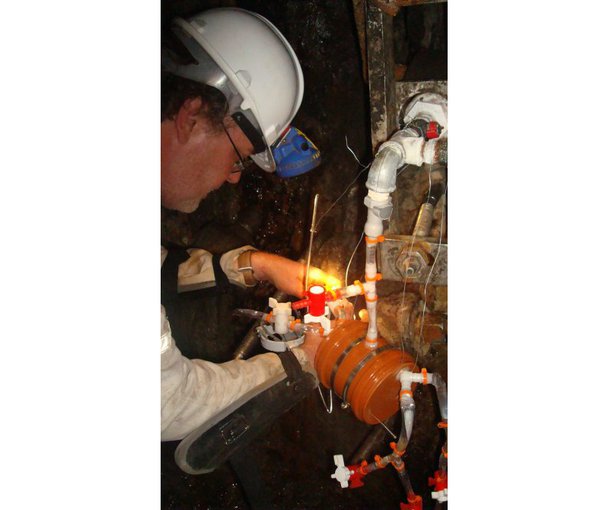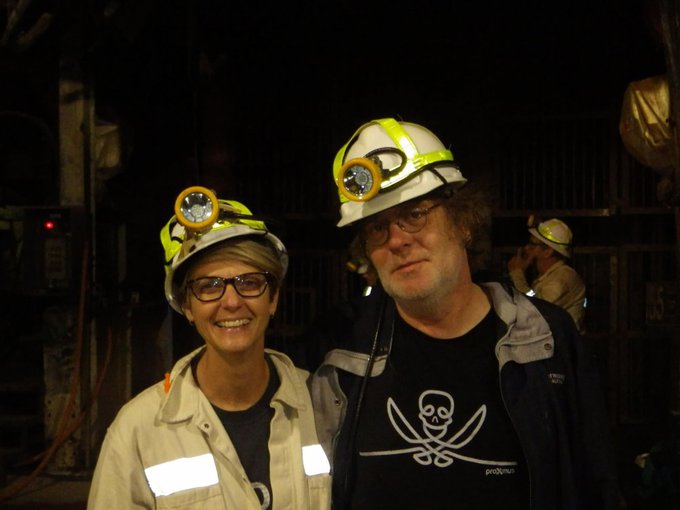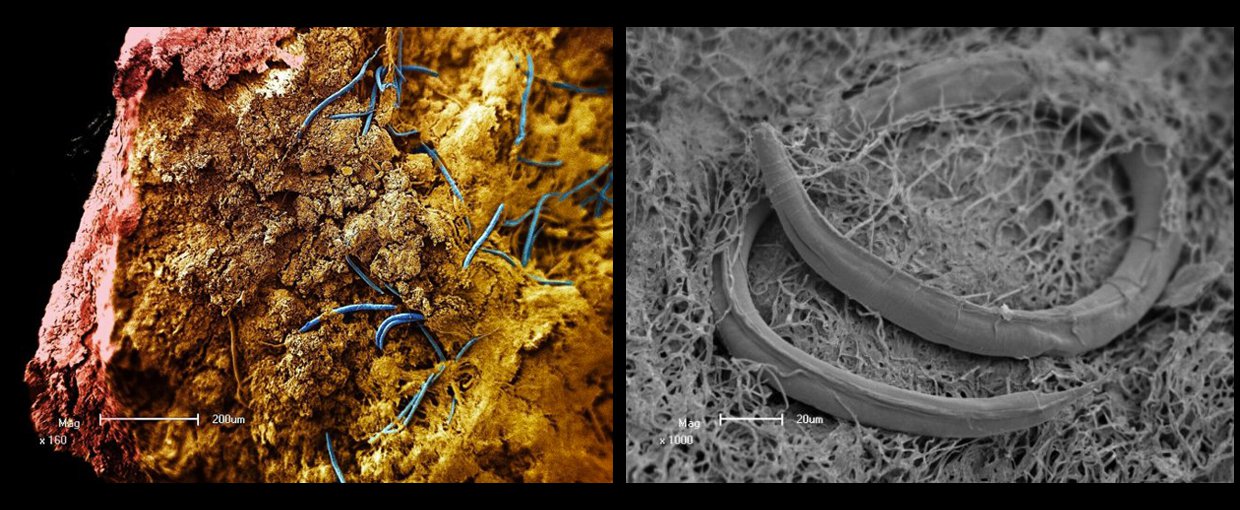

Poikilolaimus oxycercus is a microscopic nematode, or roundworm, found alive and well more than a mile below the surface in South Africa, where its ancestors had lived for hundreds or thousands of years.Image credit: Gaetan Borgonie.
When scientists speculate about possible life on Mars, they generally speak of microbial or other simple creatures living deep below the irradiated and desiccated surface. While Mars long ago had a substantial period that was wetter and warmer when it also had a far more protective atmosphere, the surface now is considered to be lethal.
But the suggestion that some potential early Martian life could have migrated into the more protected depths is often discussed as a plausible, if at this point untestable possibility. In this scenario, some of that primitive subsurface life might even have survived the eons in their buried, and protected, environments.
This thinking has gotten some support in the past decade with the discovery of bacteria and nematodes (roundworms) found as far down as three miles below the surface of South Africa, in water dated as being many thousands or millions years old. The lifeforms have been discovered by a team that has regularly gone down into the nation’s super-hot gold and platinum mines to search for life coming out of boreholes in the rock face of deep mine tunnels.

Borgonie setting up a water collector for a borehole at the Driefontein mine in the Witwatersrand Basin of South Africa.Image credit: Courtesy of Borgonie.
Now a new paper describes not only the discovery of additional deep subsurface life, but also tries to explain how the distant ancestors of the worms and bacteria and algae might have gotten there.
Their conclusion: many were pulled down when fractures opened in the aftermath of earthquakes and other seismic events. While many lifeforms were swept down, only a small percentage were able to adapt, evolve and thus survive.
The is how Gaetan Borgonie, lead author of the paper in Scientific Reports, explained it to me via email:
“After the discovery of multicellular animals in the deep subsurface up to 3.8 km (2.5 miles) in South Africa everyone was baffled and asked the question how did they get that deep? This question more or less haunted us for more than a decade as we were unable to get our head around it.
“However during the decade as we made more observations of multicellular organisms we captured in borehole water we found that these were nearly all animals associated with fresh water and not the soil. This indicated the passage to the deep was from a fresh water source on the surface and that animals did not crawl all the way down through the topsoil over millennia.”
This makes sense because the deepest soil inhabitants live at about six feet below the surface, said Borgonie, formerly of the University of Ghent in Belgium and now with ELi, a Belgian nonprofit that studies extreme life. So another route to their deep subterranean homes was necessary.

One of six hibernating nematodes found in biofilms from a borehole in the Kopanang mine. Four of the six in this “dauer” or survival state were taken, placed in a petri dish and came back to active life. Several were mated with worms of the same Poikilolaimus oxycercus species and the offspring survived.Image credit: Gaetan Borgonie.
Borgonie and his team conducted a variety of tests — seismic, geological, genetic — but one stands out as most conclusive.
At the Kopanang mine, they had found the roundworm Poikilolaimus oxycercusin in water about a mile underground. What appeared to be the same nematode was also collected from the the Vaal river, a few miles from the mine.
The two appeared to be genetically similar, but the best test was to see if they could successfully reproduce. And the answer was that they could.
It was a smoking gun, though not necessarily a common one. Nematodes from other surfaces and subsurfaces were placed together and were not able to produce young that survived. As explained in the Scientific Reports paper, this may be a function of the once companionable subsurface nematodes having adapted to their environment in ways that broke their connections with surface nematodes of the same species.
While nematodes can hibernate for long periods in what is called their dauer stage, when they wake up they survive for only 20 to 30 days. Their lines, however, can last in the subsurface for those very long periods.

Tunnels in South Africa’s Beatrix mine close to where H. mephisto was found. The deeper one goes in the mine, the hotter it gets. And yet life survives in the fracture water and other often tiny pockets of liquid.Image credit: Gaetan Borgonie.
The nematodes collected and tested for this most recent article were but a small part of the zoo of creatures that have been collected from deep underground in South Africa’s Witwatersrand Basin. There was also algae, fungi, bacteria, a crustaceans and even a few insects, the paper reports. The bacteria is important for the nematodes in particular because they are a food source.
These ecosystems survive in scalding temperatures, in the absence of sunlight, at high pressure and without oxygen. Yet they have been found as far down as almost three miles below the surface, though in far more isolated conditions at that depth.

Borgonie with Esta van Heerden, who helped gain access to South African mines for researchers including Borgonie and Princeton University geomicrobiologist Tullis Onstott more than a decade ago is part of their research team. She is founder of the mine water remediation company iwatersolutions and was formerly a professor with the University of the Free State in Bloemfontein, where she was a specialist in extremophiles.Image credit: Courtesy of Borgonie.
The age of that life is difficult to determine. While methods exist to determine the age of the fracture water, scientists cannot definitively say when the lifeforms arrived. Still, Borgonie reports that the worms found at the Kopanang mine had been present for between 3,000 and 12,000 years, or rather their ancestors had been there.
Borgonie and his colleagues had earlier discovered the first multicellular creature at great depth, Halicephalobus mephisto, in mine fracture water .6 to 3 miles down. That discovery, announced in 2011, helped establish that the deep subsurface was more able to support life, even complex life, than expected.
Often the creatures were living in biofilms, loose collections of bacteria and other life held together in the water by secretions that encase them.
Another aspect of the deep subsurface nematode story involves specimen found in salty stalactites at the Beatrix gold mine. The worms identified, Monhystrella parvella, are associated with salty environments and so the group inferred that the water and creatures may have come from a sea. There were such seas in what is now South Africa, but it was very long ago.
“M. parvella does not have a hibernation stage and cannot survive in fresh water, thus it must have been and must be in brackish water all the time,” Borgonie said. “The question is did this happen long ago when that area of South Africa was covered by a sea or did it happen via the salt pans surrounding the Beatrix mine?
“There is no way to know for now. But the fact is and remains that you have a worm in the subsurface in the middle of South Africa that can only survive in salty water.”
Recent reports of another nematode species, unaffiliated with South African mines, suggests just how robust and adaptable individuals can be — in this case regarding deep freeze hibernation.
The longest recorded nematode hibernation was 39 years until Russian scientists announced the discovery of frozen nematodes in deep Siberian permafrost. The worms had been asleep for 42,000 and 34,000 years respectively. A https://www.sciencealert.com/40-000-year-old-nematodes-revived-siberian-permafrostScience Alert article raises the possibility of contamination as an issue, but the scientists maintain they took all possible precautions and are convinced the frozen hibernations were as recorded.

Using an electron microscope, we see the inside of a stalactite in the Beatrix gold mine, about 1 mile below the surface. The nematodes are of the species Monhystrella parvella.Image credit: Gaetan Borgonie.
That the South African deep subsurface life appears now to have come from the surface — via seismic fractures that could bring rushes or trickles of water filled with life many miles down — does have possible implications for Mars. While no signs of early life on Mars have been discovered, research in recent years has proven that the planet once had substantial water and warmer temperatures. In other words, conditions that might be hospitable to life.
That theory of a once quite watery Mars was taken a significant step further last week in an article in the Journal of Geophysical Research — Planets , which found evidence of an earlier planet-wide groundwater system. Such a system had been predicted before by models, but now there was significsnt hard evidence that it had indeed existed.
“Early Mars was a watery world, but as the planet’s climate changed this water retreated below the surface to form pools and ‘groundwater’,” says lead author Francesco Salese of Utrecht University, the Netherlands.
“We traced this water in our study — as its scale and role is a matter of debate — and we found the first geological evidence of a planet-wide groundwater system on Mars.”
Salese and colleagues explored 24 deep, enclosed craters in the northern hemisphere of Mars, with floors lying roughly 4000 meters (2.5 miles) below Martian ‘sea level’ (a level that, given the planet’s lack of seas, is arbitrarily defined on Mars based on elevation and atmospheric pressure).
The scientists found features on the floors of these craters that could only have formed in the presence of water. Many craters contain multiple features, all at depths of 2.5 to 3 miles – indicating that these craters once contained pools and flows of water that changed and receded over time.

Researchers said flow channels, pool-shaped valleys and fan-shaped sediment deposits seen in dozens of kilometers-deep craters in Mars’ northern hemisphere would have needed water to form.Image credit: European Space Agency.
So an inevitable and most interesting question that arises is this: If there was robust and adaptable life on early Mars, might it have been transported underground in water too?
The planet does have seismic activity — some are called Marsquakes — that can open fractures. It seems plausible that if life existed in water on the Martian surface, it would have flowed or trickled down fractures and other porous features to substantial depths.
Given this hypothetical, many would have died but some may have lived and adapted. Rather like what can be seen on Earth in the South African mines.
With this possibility in mind, the Borgonie paper recommends that the presence of surface fractures be kept in mind when landing sites are chosen on other planets or moons.
